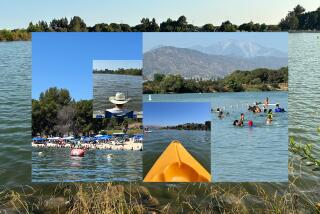LAKE TAHOE FISHING : No Magic, but Lots of Lakers
KINGS BEACH, Calif. — Tahoe, an hour before dawn. It’s 18 degrees when Mickey Daniels eases his 43-foot Big Mack II out of Tahoe Boat Company Harbor, at Kings Beach.
For about 20 minutes, the frosty air is completely windless. The image of the brilliant full moon over Tahoe’s west shore doesn’t dance on the glassy water, it holds steady and bright, like the beam of a lantern from below.
Seven fishermen, wrapped in Arctic garb, at first warm their feet on the deck, stamping their feet hard on the snow and ice. Snow and ice? Plainly, this is no typical California fishing trip. Big Mack II’s decks are covered with snow and ice, and icicles dangle from the edges and corners.
The fishermen wisecrack about the cold, and blow geysers of steam into the cold air when they laugh. When Daniels eases the rumbling sportfisher past the harbor’s buoy line and raises the throttle, the fishermen, stung on their faces and ears by the icy air, scurry into the wheelhouse with Daniels. They jostle each other for standing room by the boat’s only heater.
What are these people doing on a boat on a 6,200-foot-high lake in the Sierra Nevada, on an 18-degree morning? They are about to demonstrate that Lake Tahoe has more to offer visitors than gaming tables, on the Nevada side, or skiing, on both sides.
Tahoe has fish. Big fish. Lake trout, to be exact. Also known as mackinaw, or, if you want to sound like a local, macks or lakers.
Lake trout are found throughout Canada and the Arctic in large, clean lakes and in the United States, where they have been introduced. The species was transplanted from the Great Lakes to Tahoe in 1885, as a commercial and sport species. Biologists say lakers are more closely related to char and eastern brook trout than other trout species. They’re the largest of the trout-like fish, believed to reach 100 pounds in some waters, such as Canada’s Great Bear Lake.
Fishing for lake trout isn’t an activity that most fishermen would call a heart-stopping piscatorial encounter. The species is a deep-water fish, and the prevailing technique is deep-water trolling with big lures.
So if your bag is watching a bonefish make a charge through the shallows or seeing a barracuda imitate a Polaris missile, lake trout fishing might put you to sleep.
So, for the moment, we won’t put lake trout on the top 10 thrills list. However, in the case of Lake Tahoe, when viewed as part of a unique outdoors experience, wintertime fishing for lakers at Tahoe fare much better on the thrill scale. Doug Fritz, a teacher from Modesto, put it this way: “If these guys (two friends he’d accompanied) hadn’t talked me into this, I’d never have seen Tahoe like this. It’s beautiful in the winter, and being on the lake on a morning like this is a real treat.”
The day before, a storm had dropped a foot of snow on the Tahoe area. But this morning, the glow of the still-hidden sun revealed only a trace of clouds to the south, over the mountains above South Lake Tahoe’s casinos, the lights of which sparkled clearly, nearly 20 miles away.
Daniels and his deckhand, Arnie Hof, had just finished rigging up seven trolling rods and two deep--running rigs. He slowed the boat, a Modutech 43, to its slowest trolling speed.
Within minutes, Steve Mikel of Tahoe City was handed a bent rod. In short order, he had a four-pound laker to the stern, and Hof dropped a big hoop net underneath the flailing fish.
Daniels was trolling over a ledge in Carnelian Bay, near Flick Point. The lines were 20-pound-test, weighted by 12-ounce sinkers, and the lures were roughly 200 feet down.
Ten minutes later, John Funnel of Modesto caught his first laker ever. Then, minutes later, a triple--Mikel, Fritz and Funnell--all were fighting lakers simultaneously.
In the wheelhouse, Daniels pointed to the first piercing rays of the sun rising over an eastern ridge. The snow on the tops of the Sierra’s ridges to the west began to glow pink.
“The best fishing is at first light and look--three guys hooked up at once, as soon as the sun shows,” he said. “Generally, we catch bigger macks in the summer, when they’re spawning in the shallows. Here, we’re catching schooling fish I’m finding on the meter. They’re 200 to 300 feet down.”
Daniels, 49, has been taking people fishing for lake trout on Tahoe since 1970. He takes as many as to 12 people fishing, from dawn to 10:30 a.m., and from 2:30 p.m. to sunset. The fare is $45 per person. Tackle is provided. When he isn’t taking people fishing, he’s a constable for Placer County, for Tahoe Judicial District Court. He talked about the laker tagging program in which regular Tahoe fishermen participate with the Department of Fish and Game.
“We tag and release a lot of fish,” he said. “The tag indicates the depth at which the fish was caught, the date, its size, the location of the catch and whether or not we let the air out.”
“Letting the air out” involves piercing the fish’s air bladder with a needle. When lake trout are rapidly raised to the surface from deep water, their air bladder expands quickly. When they appear on the surface, the fish appear bloated, almost pot-bellied.
“If we release the fish like that, it can’t get below the surface, and dies,” Daniels explained. “The DFG wants to know what the survival rate is on macks that’ve had their bladders pierced.”
Almo Cordone, a California Department of Fish and Game biologist, said lake trout are doing well in Tahoe.
“Tahoe has some water quality problems for a variety of man-made reasons, but the lake trout, as far as we know, are doing fine,” he said.
The sun was now clear of the snowy eastern ridges and Tahoe had suddenly changed color, from steel gray to deep blue. On Daniels’ boat, a couple of wool caps and gloves came off, but no jackets. There was still a stinging snap to the morning air as the passengers watched both their lines and the unfolding blue/white panorama of several million snow-dusted trees rising in every direction, from the shores of a lake so blue now it you almost wondered if it was real.
Fritz took it all in and planned a return.
“I hear you catch bigger fish in the summer, but I wouldn’t trade this kind of experience,” he said. “Tahoe can’t be any more beautiful than it is on a morning like this.”
More to Read
Sign up for The Wild
We’ll help you find the best places to hike, bike and run, as well as the perfect silent spots for meditation and yoga.
You may occasionally receive promotional content from the Los Angeles Times.






